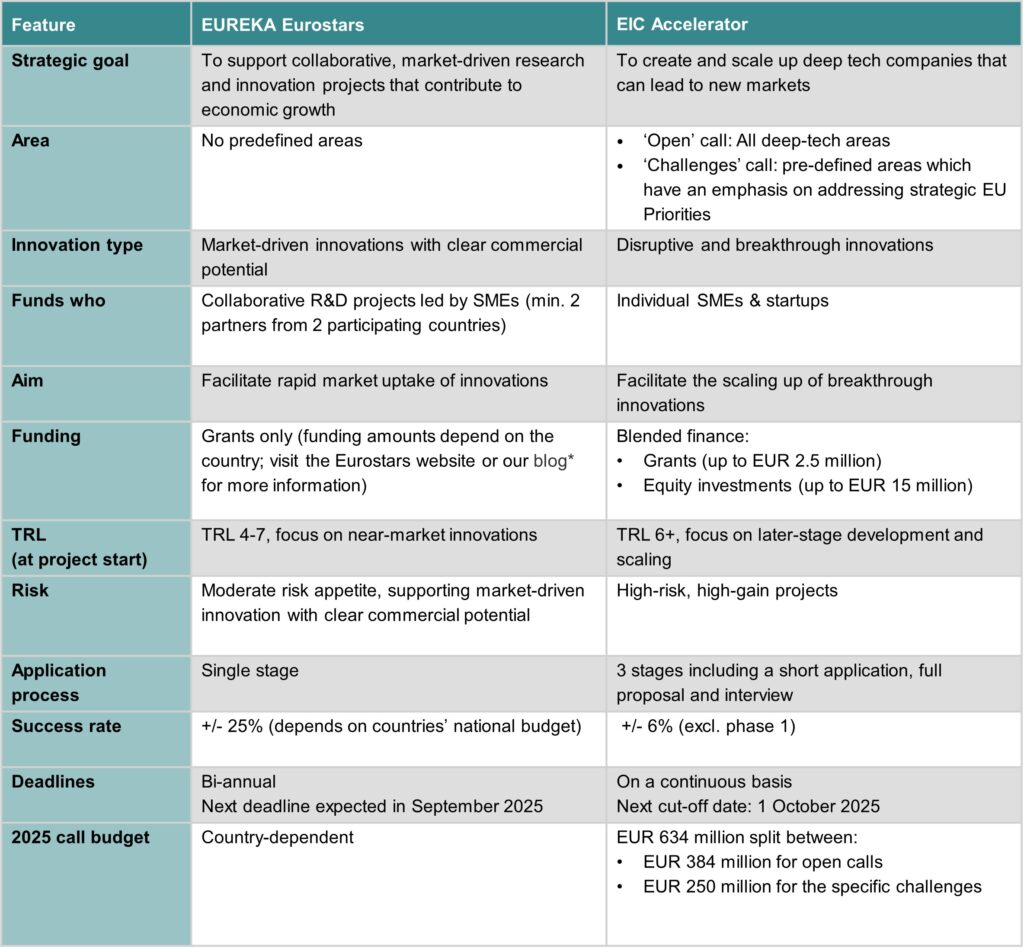Swiss companies can apply for EIC Accelerator and Eurostars again – key facts compared
25th March 2025 at 10:07 am
Now that Switzerland participates in Horizon Europe as an associated country in 2025 (provided that the final agreement with the EU is signed), Swiss small and medium-sized enterprises (SMEs), including start-up companies, are once again eligible to apply for the European Innovation Council (EIC) Accelerator funding programme. With this change, the Swiss State Secretariat for Education, Research and Innovation (SERI) has announced the discontinuation of the Swiss Accelerator programme, which served as a substitute during the period of exclusion.
At the same time, Switzerland has reopened applications for the EUREKA Eurostars 3 programme – call 8, with a submission deadline expected for September, following a temporary pause for the March call. Both the EIC Accelerator and Eurostars offer significant opportunities for small and medium-sized enterprises to fund their market-ready or near-market-ready innovations. While the specific requirements differ between both programmes, the need for a robust business case remains crucial, as discussed in our previous blog post, A strong business case for your Eurostars-3 application. However, choosing the right programme can be challenging.
While both funding schemes aim to drive innovation to the market, their focus, structure, and target audience differ significantly. In this blog post, we break down the key differences to help you decide which funding scheme is the best fit for your innovation project.
Navigating the EIC Accelerator
The EIC Accelerator is designed to support start-ups and SMEs in developing and scaling up breakthrough innovations with high market impact. The Accelerator Open calls welcome high-risk, high-gain projects across all sectors, while the so-called Accelerator Challenges try to attract projects in pre-defined areas addressing strategic EU priority areas, such as advanced materials, biotechnology, generative AI, space technologies and future mobility.
Swiss innovators performed exceptionally well in the last round of possible participation in 2020, ranking fourth among other countries and securing EUR 98.2 million for 26 companies. However, the 2025 Swiss Venture Capital Report reveals a declining trend in financing rounds for start-ups and SMEs. The EIC Accelerator, with its blended finance model (grant and equity funding), offers a potential solution for deep-tech companies seeking growth capital and addressing this declining funding trend. In the latest October 2024 cut-off, 71 start-ups and SMEs were selected for funding from a highly competitive pool of 1,211 submitted proposals. Of these, 431 applicants advanced to the jury interviews.
Understanding Eurostars
In contrast, the EUREKA Eurostars programme is tailored to support market-driven R&D projects led by innovative SMEs in collaboration with international partners. Unlike the EIC Accelerator, which focuses on individual companies, Eurostars fosters collaboration between SMEs and even with research organisations and/or larger enterprises. This makes it an ideal choice for SMEs looking to develop innovative solutions with a small network of partners while sharing expertise and resources. The funding structure also differs significantly. While the EIC Accelerator offers a blended finance option, Eurostars provides public grant funding only. Moreover, Eurostars targets a broader range of R&D projects, including those with slightly lower risk profiles, making it more accessible to SMEs with often shorter-term market-driven innovations that may not necessarily fall under the “breakthrough” category.
This table summarises the key differences between the EIC Accelerator and Eureka Eurostars funding programmes.

Key takeaways – EIC Accelerator vs Eurostars
- Collaboration vs individual focus: The EIC Accelerator is for individual companies whereas Eurostars requires international collaboration between at least two organisations from two participating Eurostars countries.
- Funding structure: EIC Accelerator offers blended finance (grants and equity), while Eurostars provides public grant funding only which is also limited in most countries up to EUR 500,000 for an SME in one project.
- Target audience: The EIC Accelerator is tailored for high-risk, high-gain companies developing deep-tech innovations aimed at disrupting markets, while Eurostars is designed for SMEs focused on collaborative, market-driven R&D projects with international partners, supporting a broader range of less radical innovations with high market potential.
- Application process and success rate: Getting EIC Accelerator funding involves a highly competitive three-step application process, with only about 6% of applicants making it through the full proposal stage, and even if you do, funding still is not guaranteed since there is one more interview stage. Eurostars, on the other hand, has a simpler, single-application process, which leads to a much better chance of getting funded with an average success rate of around 30% and requires lower effort.
Get expert support for your funding application
Choosing the right funding scheme can be the key to driving your innovation forward. At accelopment, we have long-standing experience in helping SMEs and researchers to identify the right programme, guiding you through the complex application process and maximising your chances of success. Do you have questions about the EIC or Eurostars? We offer Eurostars proposal preparation support and collaborate with experienced service providers for the EIC Accelerator. Have a look at our successful Eurostars projects like FP-Catheter, MiniLib, NoCaTS and AirToxMonitor and contact one of our experts today to explore how we can help you secure the funding your innovation deserves.

Robin Vanneste
Business & Finance Associate

